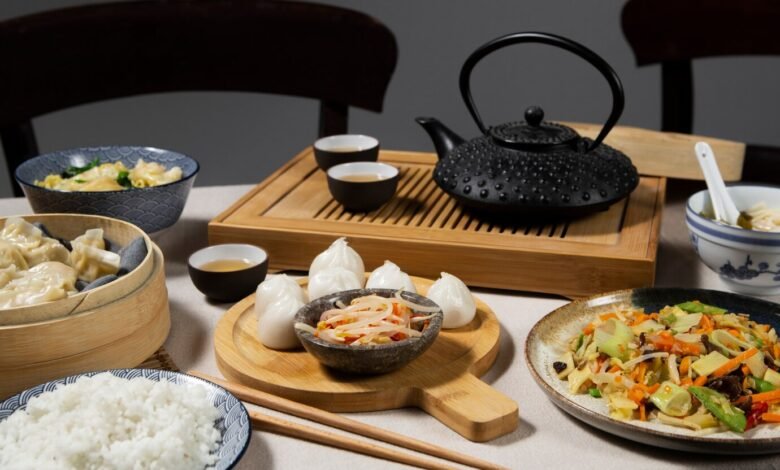China Kitchen: A Culinary Journey Through Flavors and Traditions

China’s culinary heritage is one of the richest and most diverse in the world, shaped by thousands of years of history, regional variations, and cultural influences. From the fiery spices of Sichuan to the delicate dim sum of Cantonese cuisine, Chinese food offers an endless exploration of flavors, techniques, and traditions. Whether it’s the comforting warmth of a bowl of noodles or the intricate artistry of a banquet dish, Chinese cuisine tells a story of harmony, balance, and innovation. In this article, we’ll take a deep dive into the essence of China kitchen, exploring its regional specialties, cooking methods, and the cultural significance behind its most beloved dishes.
1. The Regional Diversity of Chinese Cuisine
China kitchen vast landscape has given rise to distinct regional cuisines, each with its own unique ingredients, flavors, and cooking styles. The most famous among these are the “Eight Great Cuisines” of China: Sichuan, Shandong, Cantonese (Guangdong), Jiangsu, Zhejiang, Fujian, Hunan, and Anhui. Sichuan cuisine is known for its bold, spicy, and numbing flavors, thanks to the liberal use of chili peppers and Sichuan peppercorns. In contrast, Cantonese cuisine emphasizes freshness and subtlety, with steamed dishes, roasted meats, and delicate seafood preparations. Shandong cuisine, from the north, features hearty flavors with an emphasis on wheat-based foods like noodles and dumplings, while Jiangsu cuisine is celebrated for its refined, slightly sweet dishes and artistic presentation. Understanding these regional differences is key to appreciating the depth of Chinese culinary traditions.
2. The Art of Chinese Cooking Techniques
Chinese cooking is as much about technique as it is about ingredients. Some of the most important methods include stir-frying, steaming, braising, deep-frying, and red-cooking (a slow braising technique using soy sauce and spices). Stir-frying, perhaps the most iconic Chinese cooking method, relies on high heat and quick cooking to preserve the texture and nutrients of ingredients. Steaming is another fundamental technique, used for everything from fluffy buns to delicate fish, ensuring that natural flavors remain intact. Meanwhile, braising and stewing are essential for creating rich, deeply flavored dishes like red-braised pork or beef noodle soup. Mastery of these techniques allows Chinese chefs to transform simple ingredients into extraordinary meals, balancing taste, texture, and aroma in every bite.
3. Staple Ingredients in Chinese Cooking
No exploration of Chinese cuisine would be complete without understanding the core ingredients that form its foundation. Rice, noodles, soy products, and a wide array of vegetables are dietary staples, while proteins such as pork, chicken, fish, and tofu play central roles in many dishes. Key flavor enhancers include soy sauce, oyster sauce, hoisin sauce, fermented black beans, and aromatic spices like star anise and cinnamon. Fresh herbs and aromatics—such as ginger, garlic, scallions, and cilantro—add depth and fragrance to dishes. Additionally, dried ingredients like mushrooms, shrimp, and preserved vegetables contribute umami richness, a hallmark of Chinese cooking. The careful selection and balance of these ingredients are what make Chinese food so complex and satisfying.
4. The Cultural Significance of Chinese Food
In China kitchen food is more than just sustenance—it is deeply intertwined with culture, philosophy, and social traditions. The concept of “yin and yang” plays a crucial role in Chinese culinary practices, emphasizing balance between hot and cold, spicy and mild, and crunchy and soft textures. Festivals and family gatherings revolve around symbolic dishes, such as dumplings for prosperity during Lunar New Year or mooncakes for the Mid-Autumn Festival. Sharing meals is a way to strengthen bonds, with communal dining and dishes served family-style reflecting values of harmony and togetherness. Even the way food is presented—colorful, textured, and arranged thoughtfully—speaks to the Chinese appreciation for beauty and balance in all aspects of life.
5. Popular Chinese Dishes You Must Try
From street food to banquet delicacies, Chinese cuisine offers an endless array of must-try dishes. Peking duck, with its crispy skin and tender meat, is a Beijing specialty often served with thin pancakes and hoisin sauce. Kung Pao chicken, a Sichuan favorite, combines spicy, sweet, and nutty flavors in a stir-fry with peanuts and dried chilies. Xiaolongbao (soup dumplings) from Shanghai burst with rich broth and minced pork, requiring careful handling to enjoy properly. For noodle lovers, Lanzhou hand-pulled noodles in beef broth offer a comforting, hearty meal, while Mapo tofu delivers a fiery, flavorful punch with its silky tofu and spicy sauce. Each dish tells a story of regional identity and culinary craftsmanship, making Chinese food an adventure for the senses.
6. The Global Influence of Chinese Cuisine
Chinese food has traveled far beyond its homeland, adapting to local tastes while retaining its essence. From American-Chinese classics like General Tso’s chicken to Southeast Asian-Chinese fusion dishes like Hainanese chicken rice, the global footprint of Chinese cooking is undeniable. Chinatowns around the world serve as cultural hubs where traditional recipes are preserved and reinvented. Even cooking techniques like the wok have become universal tools in kitchens worldwide. As more people embrace authentic regional Chinese dishes—such as hot pot, dan dan noodles, and clay pot rice—the appreciation for China’s culinary heritage continues to grow, proving that great food knows no borders.
Conclusion: The Endless Delights of China Kitchen
Chinese cuisine is a celebration of history, creativity, and community, offering something for every palate. Whether you’re savoring the complex layers of a slow-cooked stew or the simplicity of a perfectly steamed bun, each dish invites you to experience the richness of China’s culinary traditions. By exploring its regional diversity, cooking techniques, and cultural significance, we gain not just a taste of delicious food but also a deeper understanding of a culture that has perfected the art of eating well. So, the next time you sit down for a Chinese meal, take a moment to appreciate the centuries of tradition and passion that went into creating it.




